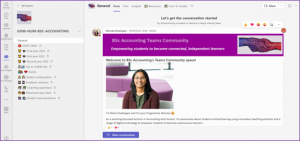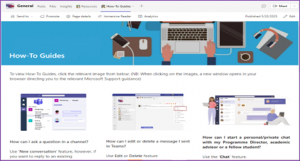How to authentically build and strengthen a sense of belonging with a student community using students as partners?

At the University of Manchester Teaching and Learning Conference held in July 2023, Reimala and her team presented on their pilot project delving into building belonging in a blended environment to cultivate meaningful connection, communication and collaboration with students as partners, and promote the student voice in an undergraduate programme. They have kindly written up their presentation as a blog and resource, found below:
The pandemic has had an adverse impact on the mental health of students resulting in a significant rise in young people struggling at university. Research suggests that mental health should be central to any strategy that seeks to develop student belonging.
As a new undergraduate programme director, I faced the challenge of providing social presence (Garrison, 2008) in a blended environment to cultivate meaningful connection, communication and collaboration with students.
This Belonging pilot project was a collaboration with Humanities e-learning and a student partner to co-create an inclusive and accessible community of practice (Wenger, 1998) for students in an undergraduate programme. Useful support networks and resources were shared to promote agency amongst students. The project closely aligns with the four foundations of belonging at university, which include connection, inclusion, support and autonomy (Wonkhe & Pearson, 2022).
Some helpful considerations when creating a community of practice for belonging purposes:
- Using Microsoft Teams
We used Microsoft Teams as it was a secure, digital platform to build connections and share files within the document collaboration space. The private chat functionality was helpful in building trust as it encouraged 1:1 chat with students and between students for ongoing interaction. Video calls for meetings were time saving and easy to manage whilst the Teams app on mobile devices was helpful in providing greater flexibility for timely responses. The use of Microsoft Teams helped alleviate concerns around students’ mental health, as more students were comfortable reaching out for support in a trusted space. There was the added benefit of improving students’ digital fluency in readiness for the workplace given the wide usage of Microsoft Teams by organisations in support of a hybrid working culture. 2
2. Cultivating meaningful connection and communication
For an undergraduate programme with different year groups, the set-up of individual channels was vital for ease of communication and peer connection.

The General channel was used to share announcements relevant to all students and a Resources tab was added to link students to their Blackboard site, Student Support website, UG Handbook and learning resources.

A How-To Guides tab was added with instructions on how to use the various features and netiquette when interacting with others.

To promote internal and external career and social events, an Events channel was created to support students’ wellbeing and employability prospects.

Private channels for each year group were created to share tailored announcements and resources. Within these private channels, students can connect with their peers and ask questions. As students’ progress to the next academic year, the channel name is updated so that they remain connected with their peers throughout their degree programme.

3. Collaborating with student partners
Private channels to facilitate collaboration with student partner groups were also created; for e.g., student representatives that support committee meetings and raise issues for satisfactory resolution, student ambassadors that support open day events and coaches that provide peer support to students.

4. Seeking feedback to promote the student voice
A variety of interventions were used to seek feedback from students and promote the student voice. The Insights app within the General channel provided useful statistics on student engagement. Student feedback was collated via surveys using MS Forms and informal face-to-face meetings with each year group. An evaluation of the feedback resulted in specific actions implemented to create structured social time for peer connection and more interactive posts to engage with students.
The benefits for staff and students are as follows:
Staff:
- Reduces repetitive email queries from students’ and frees up time to focus on other work;
- Fosters a sense of belonging and meaningful connection with students on the programme;
- Helps build trust with students to reach out for targeted support;
- Promotes collaboration with student partners to seek feedback and promote the student voice.
Students:
- Promotes a sense of belonging to reduce feelings of isolation and anxiety;
- Become autonomous learners by taking control and making choices using shared resources;
- Seek out employment opportunities and widen networks through active participation in advertised career events;
- Engage in social events to improve peer connection within year group and across the programme.
Above all, this community of practice has fostered a sense of belonging to create a more positive university experience for students.
More information and support available
If you are keen to create a community of practice for your students, please get in touch with us:
- Reimala Sivalingam – reimala.sivalingam@manchester.ac.uk (BSc Accounting Programme Director)
- Hamza Badenjiki – hamza.badenjiki@manchester.ac.uk (Humanities e-learning technologist)
To help you get started, please browse the website link shared for access to various How-To guides created: https://sway.office.com/hH3HHGtuwvWITddi?ref=Link. For detailed guidance on setting up your own community of practice, please access the recording of the Teaching Online workshop session titled ‘Building a Sense of Belonging for a Student Community using MS Teams’.
References
Garrison, D. R. & Vaughan, N. (2008). Blended learning in higher education: Framework, principles and guidelines. San Francisco: Jossey-Bass [Online] Available at: https://r4.vlereader.com/Reader?ean=9781118180174
Wenger, E. (1998) Communities of Practice: Learning, Meaning and Identity, Cambridge University Press.
Wonkhe & Pearson, (2022) The four foundations of belonging at university. Available at: https://wonkhe.com/blogs/the-four-foundations-of-belonging-at-university/







0 Comments